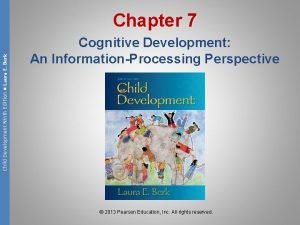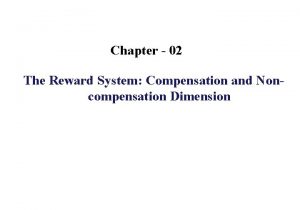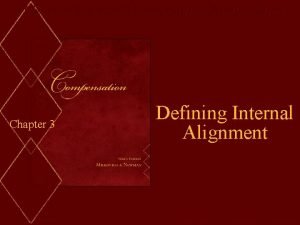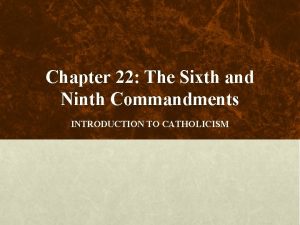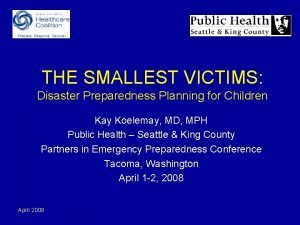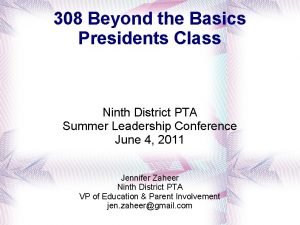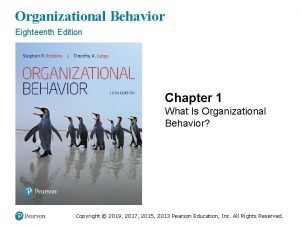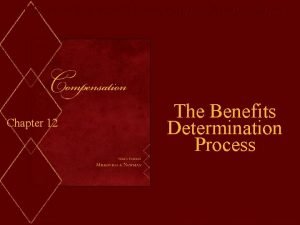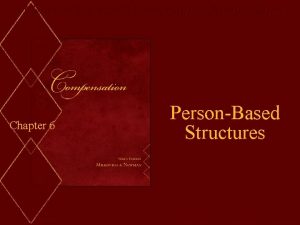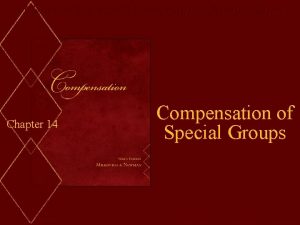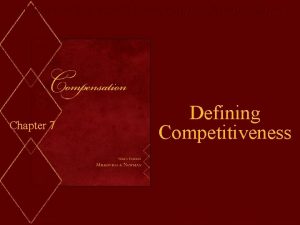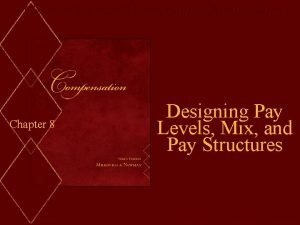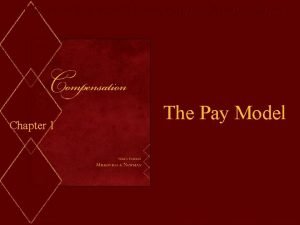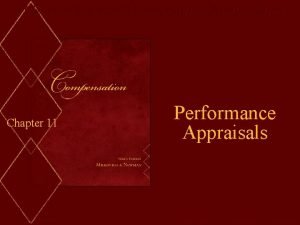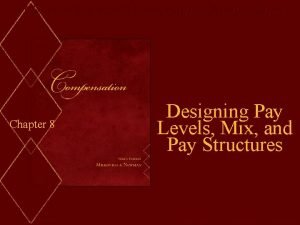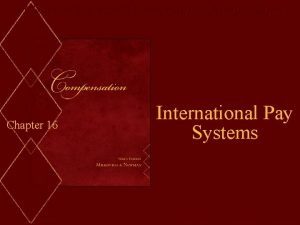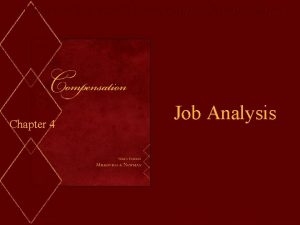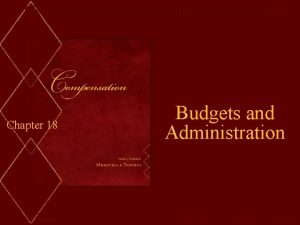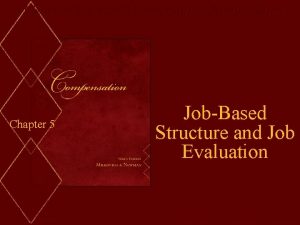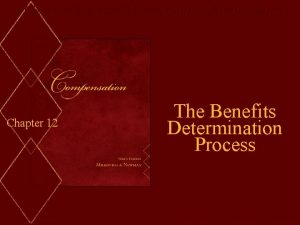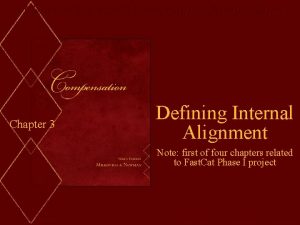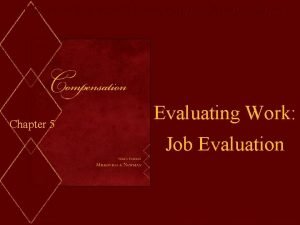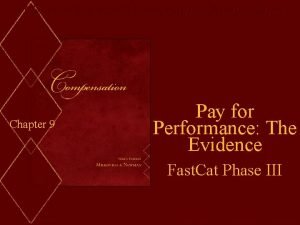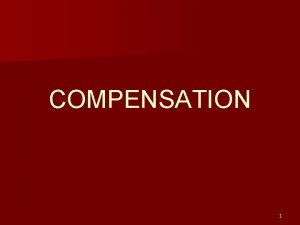MilkovichNewman Compensation Ninth Edition Chapter 2 Mc GrawHillIrwin































- Slides: 31

Milkovich/Newman: Compensation, Ninth Edition Chapter 2 Mc. Graw-Hill/Irwin Strategy: The Totality of Decisions Copyright © 2008 by The Mc. Graw-Hill Companies, Inc. All rights reserved.

Chapter Topics n Similarities n Strategic n Support n The and Differences in Strategies Choices Business Strategy Pay Model Guides Strategic Pay Decisions n Developing Four Steps n Source n “Best a Total Compensation Strategy: of Competitive Advantage: Three Tests Practices” versus “Best Fit” n Guidance from the Evidence 2 -2

Exhibit 2. 1: Three Compensation Strategies 2 -3

Similarities and Differences in Strategies n Different strategies within the same industry n Different strategies within the same company n “Let the market decide our compensation” philosophy is untenable in the real world, especially in global environments 2 -4

Strategic Choices n Strategy refers to the fundamental directions that an organization chooses – Corporate level: “What business should we be in? ” – Business unit level: “How to gain and sustain competitive advantage? ” – Functional level: “How should total compensation help gain and sustain competitive advantage? ” n A strategic perspective focuses on those compensation choices that help the organization gain and sustain competitive advantage 2 -5

Exhibit 2. 2: Strategic Choices 2 -6

Support Business Strategy n Pay systems should align with the organization's business strategy – Based on contingency notions n Compensation systems can be tailored to: – Innovator business strategy – Cost cutter business strategy – Customer-focused business strategy n When business strategies change, pay systems should also change 2 -7

Exhibit 2. 3: Tailor the Compensation System to the Strategy 2 -8

Exhibit 2. 4: IBM’s Strategic Principles and Priorities 2 -9

Five Strategic Guidelines for Compensation Choices n Objectives n Internal Alignment n External Competitiveness n Employee Contributions n Management 2 -10

The Pay Model Guides Strategic Pay Decisions n Decisions based on the five strategic compensation choices of the pay model, taken together, form a pattern that becomes an organization's compensation strategy – Stated versus Unstated Strategies 2 -11

Example: The Strategic Compensation Decisions Facing Whole Foods n Objectives: How should compensation support business strategy and be adaptive to the cultural and regulatory global environment? Whole Foods’ Objectives – Increase shareholder value through profits and growth – Go to extraordinary lengths to satisfy and delight customers – Seek and engage employees who are going to help the company make money 2 -12

Example: The Strategic Compensation Decisions Facing Whole Foods (cont. ) n Internal Alignment: How differently should the various types and levels of skills and work be paid within the organization? Whole Foods’ Approach – Store operations are organized around eight to ten self-managed teams – Egalitarian, shared-fate philosophy – executive salaries do not exceed 14 times the average pay of full-time employees – All full-time employees qualify for stock options, and 94 percent of the company's options go to nonexecutive employees 2 -13

Example: The Strategic Compensation Decisions Facing Whole Foods (cont. ) n External competitiveness: How should total compensation be positioned against our competitors? What forms of compensation should we use? Whole Foods’ Approach – Offer a unique deal compared to competitors – Provide health insurance for all full-time employees – 20 hours of paid time a year to do volunteer work 2 -14

Example: The Strategic Compensation Decisions Facing Whole Foods (cont. ) n Employee contributions: Should pay increases be based on individual and/or team performance, on experience and/or continuous learning, on improved skills, on changes in cost of living, on personal needs, and/or on each business unit’s performance? Whole Foods’ Approach – A shared fate – every four weeks, assess the performance of each team – Top teams get an extra $1. 50 to $2. 00 an hour in the next pay period 2 -15

Example: The Strategic Compensation Decisions Facing Whole Foods (cont. ) n Management: How open and transparent should pay decisions be to all employees? Who should be involved in designing and managing the system? Whole Foods’ Approach – “No-secrets” management; every store has a book listing the previous year's pay for every employee including executives – “You Decide” – employees recently voted to pick their health insurance rather than having one imposed by leadership 2 -16

Exhibit 2. 5: Key Steps In Formulating a Total Compensation Strategy 2 -17

Developing A Total Compensation Strategy: Four Steps n Step 1: Assess total compensation implications n Step 2: Map a total compensation strategy n Steps 3: Implement strategy n Step 4: Reassess 2 -18

Step 1: Assess Total Compensation Implications n Competitive Dynamics – Business Understand the – Changing customer needs – Competitors’ actions – Changing labor market conditions – Changing Laws – Globalization n Competitive dynamics can be assessed globally 2 -19

Exhibit 2. 6: Toshiba’s Managerial Compensation Plan, Annual Amount (in Yen) 2 -20

Step 1: Assess Total Compensation Implications (cont. ) n Culture/values – A pay system reflects the values that guide an employer's behavior and underlie its treatment of employees n Social and political context – Context refers to legal and regulatory requirements, cultural differences, changing workforce, demographics, expectations etc. – Affects compensation choices – Lobbying is also part of compensation strategies 2 -21

Exhibit 2. 7: Medtronic Values 2 -22

Step 1: Assess Total Compensation Implications (cont. ) Employee preferences – How to better satisfy individual needs and preferences n Choice – Examples: Flexible benefits and choices n Union preferences – Pay strategies need to be adapted to the nature of the union-management relationship – Unions' interests can differ – Compensation deals with unions can be costly to change n 2 -23

Step 1: Assess Total Compensation Implications (cont. ) n Prominence of pay in overall HR strategy: Supporting player or catalyst for change – Pay strategy is influenced by how it fits with other HR systems – High-performance systems § High skill/knowledge requirements § Work designed so that employee teams enjoy discretion in making decisions and continue to learn § Pay systems based on performance – Pay can be a supporting player or a catalyst for change 2 -24

Step 2: Map a Total Compensation Strategy n Mapping is used in marketing to clarify and communicate a product's identity n Offers picture of a company’s compensation strategy based on the five choices in the pay model n Clarifies the message the company is trying to establish with its compensation system n Maps do not tell which strategy is the “best”, providing rather framework and guidance 2 -25

Exhibit 2. 8: Contrasting Maps Of Microsoft And SAS 2 -26

Steps 3 and 4: Implement and Reassess n Step 3 – Involves implementing strategy through the design and execution of compensation system n Step 4 – Reassess and realign, closes the loop and recognizes that the strategy must be changing to fit changing conditions – Involves periodic reassessment 2 -27

Sources of Competitive Advantage: Three Tests n Three tests determine if a pay strategy is a source of advantage n Is it aligned? n Does it differentiate? n Does it add value? Which hat is unique? – Calculate the return on investment (ROI) 2 -28

Best Practices” Versus “Best Fit”? Best Practices n. Assumptions Best Fit n If design of pay system – A set of best-pay practices exists – Reflects company’s strategy and values – Practices can be applied universally across all situations – Is responsive to employees’ and unions’ needs – Results in better performance with almost any business strategy – Is globally competitive § Company is more likely to achieve competitive advantage 2 -29

Guidance from the Evidence n Consistent research evidence that the following practices do matter to the organization's objectives – Internal alignment § Pay differences among internal jobs can affect results – External competitiveness § Paying higher than average paid by competitors can affect results – Employee contributions § Performance-based pay can affect results 2 -30

Guidance from the Evidence (cont. ) – Managing compensation § Need to consider all dimensions of pay strategy – Compensation strategy § Embedding compensation strategy within the broader HR strategy affects results n “What practices pay off best under what conditions” is an important question to be answered 2 -31
 Psychology ninth edition in modules
Psychology ninth edition in modules Macroeconomics ninth edition
Macroeconomics ninth edition Anatomy and physiology edition 9
Anatomy and physiology edition 9 Psychology ninth edition david g myers
Psychology ninth edition david g myers Social psychology ninth edition
Social psychology ninth edition Biology ninth edition
Biology ninth edition Child development laura berk 9th edition
Child development laura berk 9th edition Child development 9th edition
Child development 9th edition Fundamentals of abnormal psychology ninth edition
Fundamentals of abnormal psychology ninth edition Psychology ninth edition in modules
Psychology ninth edition in modules David myers psychology 9th edition
David myers psychology 9th edition Biology ninth edition
Biology ninth edition Campbell ninth edition
Campbell ninth edition Compensation and non compensation dimensions
Compensation and non compensation dimensions Milkovich newman compensation, 9th edition pdf
Milkovich newman compensation, 9th edition pdf 6th and 9th commandments
6th and 9th commandments The sixth and ninth commandments
The sixth and ninth commandments Phos greek root
Phos greek root Ramadan is the ninth month of the islamic calendar
Ramadan is the ninth month of the islamic calendar William blount 9th grade academy
William blount 9th grade academy Lower ninth ward
Lower ninth ward French classical menu sequence with example
French classical menu sequence with example Ninth district pta
Ninth district pta Mis chapter 6
Mis chapter 6 Using mis (10th edition)
Using mis (10th edition) Organizational behavior 18th edition
Organizational behavior 18th edition Thermodynamic vs kinetic control
Thermodynamic vs kinetic control Mechanics of materials chapter 10 solutions
Mechanics of materials chapter 10 solutions Chapter 7 beer
Chapter 7 beer Mechanics of materials chapter 6
Mechanics of materials chapter 6 Mechanics of materials chapter 5 solutions
Mechanics of materials chapter 5 solutions Mechanics of materials chapter 10 solutions pdf
Mechanics of materials chapter 10 solutions pdf






